Coffee roasting
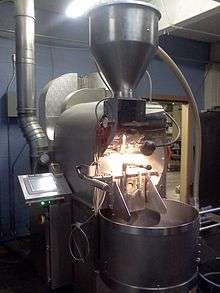
Roasting coffee transforms the chemical and physical properties of green coffee beans into roasted coffee products. The roasting process is what produces the characteristic flavor of coffee by causing the green coffee beans to change in taste. Unroasted beans contain similar if not higher levels of acids, protein, sugars, and caffeine as those that have been roasted, but lack the taste of roasted coffee beans due to the Maillard and other chemical reactions that occur during roasting.
The vast majority of coffee is roasted commercially on a large scale, but small-scale commercial roasting has grown significantly with the trend toward "single-origin" coffees served at speciality shops. Some coffee drinkers even roast coffee at home as a hobby in order to both experiment with the flavor profile of the beans and ensure the freshest possible roast.
The first recorded implements for roasting coffee beans were thin pans made from metal or porcelain, used in the 15th century in the Ottoman Empire and Greater Persia. In the 19th century, various patents were awarded in the U.S. and Europe for commercial roasters, to allow for large batches of coffee. In the 1950s just as instant coffee was becoming a popular coffee drink, speciality coffee-houses began opening to cater to the connoisseur, offering a more traditionally brewed beverage. In the 1970s, more speciality coffee houses were founded, ones that offered a variety of roasts and beans from around the world. In the 1980s and 1990s, the gourmet coffee industry experienced great growth.
History

The first known implements for roasting coffee beans were thin, circular, often perforated pans made from metal or porcelain, used in the 15th century in the Ottoman Empire and Greater Persia. This type of shallow, dished pan was equipped with a long handle so that it could be held over a brazier (a container of hot coals) until the coffee was roasted. The beans were stirred with a slender spoon. Only a small amount of beans could be heated at one time.[1] The first cylinder roaster with a crank to keep the beans in motion appeared in Cairo around 1650. It was made of metal, most commonly tinned copper or cast iron, and was held over a brazier or open fire. French, Dutch and Italian variations of this design quickly appeared. These proved popular over the next century in Europe, England and the American colonies.[2]
In the 19th century, various patents were awarded in the U.S. and Europe for commercial roasters, to allow for large batches of coffee. Nevertheless, home roasting continued to be popular. A man working at a commercial roasting plant beginning in the 1850s in St. Louis, Missouri, said that "selling roasted coffee was up-hill work, as everyone roasted coffee in the kitchen oven."[3] Appliances catering to the home roaster were developed; in 1849 a spherical coffee roaster was invented in Cincinnati, Ohio, for use on the top of a wood-fired kitchen stove, fitted into a burner opening. Green beans were available at the local general store, or even through mail order.[4] For roasting, many people used such simple methods as a layer of beans on a metal sheet in the oven, or beans stirred in a cast iron skillet over a fire. Despite the wide popularity of home roasting, Burns felt that it would soon disappear because of the great strides made in commercial roasting in the 1860s and 1870s, including the benefits of the economies of scale. The commercial roaster inventions patented by Burns revolutionized the U.S. roasting industry,[5] much like the innovations of inventors in Emmerich am Rhein greatly advanced commercial coffee roasting in Germany.[6] As well, the 1864 marketing breakthrough of the Arbuckle Brothers in Philadelphia, introducing the convenient one-pound (0.45 kg) paper bag of roasted coffee, brought success and imitators.[7] From that time commercially roasted coffee grew in popularity until it gradually overtook home roasting during the 1900s in America.[4] In 1903 and 1906 the first electric roasters were patented in the U.S. and Germany, respectively; these commercial devices eliminated the problem of smoke or fuel vapor imparting a bad taste to the coffee.[8] In France, the home roaster did not yield to the commercial roaster until after the 1920s, especially in rural areas. Coffee was roasted to a dark color in small batches at home and by shopkeepers, using a variety of appliances including ones with a rotating cylinder of glass, sheet iron or wire mesh, and ones driven by hand, clockwork or electric motor. Because of the smoke and blowing chaff, country dwellers generally roasted outdoors.[9]
In the 1950s just as instant coffee was becoming a popular coffee drink, speciality coffee-houses began opening to cater to the connoisseur, offering a more traditionally brewed beverage. In the 1970s, more speciality coffee houses were founded, ones that offered a variety of roasts and beans from around the world. In the 1980s and 1990s, the gourmet coffee industry experienced great growth.[10] Through the 1970s and 1980s, the Siemens Sirocco home roaster was made in West Germany and marketed globally. It was a small fluid-bed roaster made for the home enthusiast. The product was named after a commercial hot-air roasting process which itself was named after the hot Sahara winds called sirocco.[11] In 1976, chemical engineer Michael Sivetz patented a competing hot air design for manufacture in the U.S.; this became popular as an economical alternative. Sivetz called for the home roaster to focus on the quality of the bean.[12] From 1986 through 1999 there was a surge in the number of patents filed for home roasting appliances.[13] In the 1990s, more electric home roasting equipment became available, including drum roasters, and variations on the fluid-bed roaster. By 2001, gourmet coffee aficionados were using the internet to purchase green estate-grown beans for delivery by mail.[14]
Process
The coffee-roasting process follows coffee processing and precedes coffee brewing. It consists essentially of sorting, roasting, cooling, and packaging but can also include grinding in larger-scale roasting houses. In larger operations, bags of green coffee beans are hand- or machine-opened, dumped into a hopper, and screened to remove debris. The green beans are then weighed and transferred by belt or pneumatic conveyor to storage hoppers. From the storage hoppers, the green beans are conveyed to the roaster. Initially, the process is endothermic (absorbing heat), but at around 175 °C (347 °F) it becomes exothermic (giving off heat).[15] For the roaster, this means that the beans are heating themselves and an adjustment of the roaster's heat source might be required. At the end of the roasting cycle, the roasted beans are dumped from the roasting chamber and air cooled with a draft inducer.
During the roasting process, coffee beans tend to go through a weight loss of about 28% due to the loss of water and volatile compounds. Although the beans experience a weight loss, the size of the beans are doubled after the roasting process due to the release of carbon dioxide, release of volatile compounds, and water vaporization.[16]
In Vietnam coffee is often coated with oil (traditionally clarified butter) and a small amount of sugar prior to roasting to produce a "butter roast". The roasting process results in an additional caramelized coating on the beans.[17]
Equipment
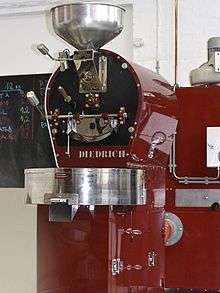
The most common roasting machines are of two basic types: drum and hot-air, although there are others including packed-bed, tangential and centrifugal roasters. Roasters can operate in either batch or continuous modes. Home roasters are also available.
Drum machines consist of horizontal rotating drums that tumble the green coffee beans in a heated environment. The heat source can be supplied by natural gas, liquefied petroleum gas (LPG), electricity, or even wood. The most common employ indirectly heated drums where the heat source is under the drum. Direct-fired roasters are roasters in which a flame contacts the beans inside the drum; very few of these machines are still in operation.
Fluid bed or hot-air roasters force heated air through a screen or perforated plate under the coffee beans with sufficient force to lift the beans. Heat is transferred to the beans as they tumble and circulate within this fluidized bed.
Roasts
Some coffee roasters use names for the various degrees of roast, such as "city roast" and "French roast", for the internal bean temperatures found during roasting. Recipes known as "roast profiles" indicate how to achieve flavor characteristics. Any number of factors may help a person determine the best profile to use, such as the coffee's origin, variety, processing method, moisture content, bean density, or desired flavor characteristics. A roast profile can be presented as a graph showing time on one axis and temperature on the other, which can be recorded manually or using computer software and data loggers linked to temperature probes inside various parts of the roaster.[18]
The most popular, but probably the least accurate, method of determining the degree of roast is to judge the bean's color by eye (the exception to this is using a spectrophotometer to measure the ground coffee reflectance under infrared light and comparing it to standards such as the Agtron scale). As the coffee absorbs heat, the color shifts to yellow and then to increasingly darker shades of brown. During the later stages of roasting, oils appear on the surface of the bean. The roast will continue to darken until it is removed from the heat source. Coffee also darkens as it ages, making color alone a poor roast determinant. Most roasters use a combination of temperature, smell, color, and sound to monitor the roasting process.
Sound is a good indicator of temperature during roasting. There are two temperature thresholds called "cracks" that roasters listen for. At approximately 196 °C (385 °F), the coffee will emit a cracking sound. This point is referred to as "first crack," marking the beginnings of a "light roast". At first crack, a large amount of the coffee's moisture has been evaporated and the beans will increase in size. When the coffee reaches approximately 224 °C (435 °F), it emits a "second crack", this sound represents the structure of the coffee starting to collapse. If the roast is allowed to progress further, the coffee will soon fully carbonize, and eventually combust.
These images depict samples taken from the same batch of a typical Brazilian green coffee at various bean temperatures with their subjective roast names and descriptions.[19]
| Unroasted | |||
 | 22 °C (72 °F) Green Beans Green coffee as it arrives at the dock. They can be stored for approximately 12-18 months in a climate controlled environment before quality loss is noticeable. |
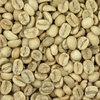 | 165 °C (329 °F) Drying Phase During the drying phase the beans are undergoing an endothermic process until their moisture content is evaporated, signifying first crack. |
| Light roast | |||
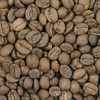 | 196 °C (385 °F) Cinnamon Roast A very light roast level which is immediately at first crack. Sweetness is underdeveloped, with prominent toasted grain, grassy flavors, and sharp acidity prominent. |
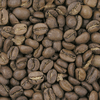 | 205 °C (401 °F) Light Roast Moderate light brown, but still mottled in appearance. A preferred roast for some specialty roasters, highlights origin characteristics as well as complex acidity. |
| Medium roast | |||
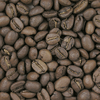 | 210 °C (410 °F) American Roast Medium light brown, developed during first crack. Acidity is slightly muted, but origin character is still preserved. |
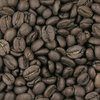 | 219 °C (426 °F) City Roast Medium brown, common for most specialty coffee. Good for tasting origin character, although roast character is noticeable. |
| Dark roast | |||
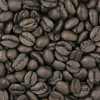 | 225 °C (437 °F) Full City Roast Medium dark brown with occasional oil sheen, roast character is prominent. At the beginning of second crack. |
 | 230 °C (446 °F) Vienna Roast Moderate dark brown with light surface oil, more bittersweet, caramel flavor, acidity muted. In the middle of second crack. Any origin characteristics have become eclipsed by roast at this level. |
 | 240 °C (464 °F) French Roast Dark brown, shiny with oil, burnt undertones, acidity diminished. At the end of second crack. Roast character is dominant, none of the inherent aroma or flavors of the coffee remain.[20] |
 | 245 °C (473 °F) Italian Roast Nearly black and shiny, burnt tones become more distinct, acidity nearly eliminated, thin body.[21] |
Flavors
At lighter roasts, the coffee will exhibit more of its "origin character"—the flavors created by its variety, processing, altitude, soil content, and weather conditions in the location where it was grown.[22] As the beans darken to a deep brown, the origin flavors of the bean are eclipsed by the flavors created by the roasting process itself. At darker roasts, the "roast flavor" is so dominant that it can be difficult to distinguish the origin of the beans used in the roast.
Below, roast levels and their respective flavors are described. These are qualitative descriptions, and thus subjective.
| Common roast names | Notes | Surface | Flavor | |
|---|---|---|---|---|
| Light | Cinnamon, American, Half City, Moderate-light Roast[23] | After several minutes the beans “pop” or "crack" and visibly expand in size. This stage is called first crack. | Dry | Lighter-bodied, higher acidity, no obvious roast flavor. This level of roast is ideal for tasting the full origin character of the coffee. |
| Medium | City, City+, Full City | After being developed through first crack, the coffee reaches these roast levels. | Dry | Sugars have been further caramelized, and acidity has been muted. This results in coffee with higher body, but some roast flavor imposed. |
| Dark | Full City+, Italian, Viennese, French | After a few more minutes the beans begin popping again, and oils rise to the surface. This is called second crack. | Shiny. The level of oil correlates to how far the coffee is taken past second crack. | Bittersweet flavors are prominent, aromas and flavors of roast become clearly evident. Little, if any, origin character remains. |
When describing the taste of coffee, the 3 tier coffee flavor tasters wheel is used based on 99 different attributes.
Caffeine content varies by roast level. Caffeine diminishes with increased roasting level: light roast, 1.37%; medium roast, 1.31%; and dark roast, 1.31%.[24] However, this does not remain constant in coffee brewed from different grinds and brewing methods. Because the density of coffee changes as it is roasted, different roast levels will contain respectively different caffeine levels when measured by volume or mass, though the bean will still have the same caffeine.
Home roasting
Home roasting is the process of roasting small batches of green coffee beans for personal consumption. Even after the turn of the 20th century, it was more common for at-home coffee drinkers to roast their coffee in their residence than it was to buy pre-roasted coffee. Later, home roasting faded in popularity with the rise of the commercial coffee roasting companies. In recent years home roasting of coffee has seen a revival.[25] In some cases there is an economic advantage, but primarily it is a means to achieve finer control over the quality and characteristics of the finished product.
Packaging
Extending the shelf life of roasted coffee relies on maintaining an optimum environment to protect it from exposure to heat, oxygen, and light. Roasted coffee has an optimal typical shelf life of two weeks, and ground coffee about 15 minutes. Without some sort of preservation method, coffee becomes stale. The first large-scale preservation technique was vacuum packing in cans. However, because coffee emits CO2 after roasting, coffee to be vacuum-packed must be allowed to de-gas for several days before it is sealed. To allow more immediate packaging, pressurized canisters or foil-lined bags with pressure-relief valves can be used. Refrigeration and freezing retards the staling process. Roasted whole beans can be considered fresh for up to one month if kept cool. Once coffee is ground it is best used immediately.
Emissions and control
Particulate matter (PM), volatile organic compounds (VOC), organic acids, and combustion products are the principal emissions from coffee processing.[26] Several operations are sources of PM emissions, including the cleaning and destoning equipment, roaster, cooler, and instant coffee drying equipment. The roaster is the main source of gaseous pollutants, including alcohols, aldehydes, organic acids, and nitrogen and sulfur compounds. Because roasters are typically natural gas-fired, carbon monoxide (CO) and carbon dioxide (CO2) emissions result from fuel combustion. Decaffeination and instant coffee extraction and drying operations may also be sources of small amounts of VOC. Emissions from the grinding and packaging operations typically are not vented to the atmosphere.
Particulate matter emissions from the roasting and cooling operations are typically ducted to cyclones before being emitted to the atmosphere. Gaseous emissions from roasting operations are typically ducted to a thermal oxidiser or thermal catalytic oxidiser following PM removal by a cyclone. Some facilities use the burners that heat the roaster as thermal oxidisers. However, separate thermal oxidisers are more efficient because the desired operating temperature is typically between 650–816 °C (1,202–1,501 °F), which is 93–260 °C (199–500 °F) more than the maximum temperature of most roasters. Some facilities use thermal catalytic oxidizers, which require lower operating temperatures to achieve control efficiencies that are equivalent to standard thermal oxidisers. Catalysts are also used to improve the control efficiency of systems in which the roaster exhaust is ducted to the burners that heat the roaster. Emissions from spray dryers are typically controlled by a cyclone followed by a wet scrubber.
Gallery
-

Diedrich IR Series Coffee Roaster.
-
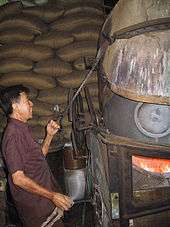
An old wood-fired coffee roaster.
-
A two-barrel coffee roaster for roasting coffee samples prior to purchasing or roasting green coffee beans.
-

An antique "Mignon" five-barrel test roasting machine.
-

The roasting room at a midsize coffee company.
See also
References
- ↑ Ukers, William Harrison (1922). All About Coffee. Tea and Coffee Trade Journal Company. p. 615.
- ↑ Ukers 1922, pp. 616–618
- ↑ Ukers 1922, p. 631
- 1 2 Owen, Tom (November 2013). "The Home Roasting Tradition". Tiny Joy. Sweet Maria's Coffee: 1–2.
- ↑ Ukers 1922, p. 634
- ↑ Ukers 1922, pp. 638–639
- ↑ Pendergrast, Mark (2010). Uncommon Grounds: The History of Coffee and How It Transformed Our World. Basic Books. p. 48. ISBN 0465024041.
- ↑ Ukers 1922, p. 647
- ↑ Ukers 1922, pp. 646, 678
- ↑ Robertson, Carol (2010). The Little Book of Coffee Law. American Bar Association. p. 110. ISBN 1616327960.
- ↑ Davids, 2003, p. 126.
- ↑ Pendergrast 2010, p. 296.
- ↑ Clarke, Ronald; Vitzthum, O. G. (2008). Coffee: Recent Developments. John Wiley & Sons. p. 104. ISBN 0470680210.
- ↑ Sinnott, Kevin (2010). The Art and Craft of Coffee: An Enthusiast's Guide to Selecting, Roasting, and Brewing Exquisite Coffee. Quarry Books. pp. 42, 60. ISBN 1592535631.
- ↑ Raemy A, Lambelet P. A calorimetric study of self-heating in coffee and chicory. Int J Food Sci & Tech, 1982;17(4):451–460.
- ↑ Edzuan, A. M. Fareez; Aliah, A. M. Noor; Bong, H. L.; Edzuan, A. M. Fareez; Aliah, A. M. Noor; Bong, H. L. (2015-01-01). "Physical and Chemical Property Changes of Coffee Beans during Roasting". American Journal of Chemistry. 5 (3A). ISSN 2165-8781.
- ↑ Eckhardt, Robyn (November 6, 2009). "Asia's best coffee – Vietnam". The Wall Street Journal. Retrieved 2014-12-02.
- ↑ "Coffee Roasts Guide".
- ↑ "Glossary of Coffee and Espresso Terms". Coffee Review. Retrieved 2012-07-28.
- ↑ "Glossary of Coffee and Espresso Terms". Coffee Review. Retrieved 2012-07-28.
- ↑ "Glossary of Coffee and Espresso Terms". Coffee Review. Retrieved 2012-07-28.
- ↑ Gene Spiller (9 October 1997). Caffeine. Los Altos, California, USA: SPHERA Foundation. p. 85. ISBN 978-0-8493-2647-9.
- ↑ This roast was previously referred to as New England Roast which is a federally registered trademark of New England Tea & Coffee Company, LLC
- ↑ Verlengia F, Rigitano A, Nery JP, Tosello A. Variations of the caffeine content in coffee beverages. ASIC, 2nd Int Sci Colloq Green and Roasted Coffee Chem. 1965, 106-114.
- ↑ Davids, Kenneth. Home Coffee Roasting: Romance and Revival. St. Martin's Griffin; revised edition, November 2003. ISBN 978-0-312-31219-0
- ↑ http://www.epa.gov/ttn/chief/ap42/ch09/final/c9s13-2.pdf
